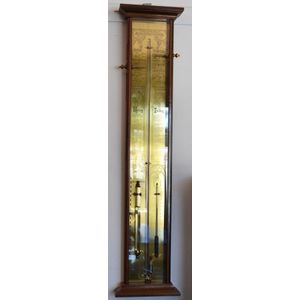Empire Style Mantel Mirror with Gilt Bronze Embellishments
You must be a subscriber, and be logged in to view price and dealer details.
Subscribe Now to view actual auction price for this item
When you subscribe, you have the option of setting the currency in which to display prices to $Au, $US, $NZ or Stg.
- Empire Style - The Empire style was a version of neo-classicism popular from 1800 to 1830, coinciding with the rule of Napoleon I from 1840-15. In England the style corrosponds with the Regency style and in the United States to the Federal style.
The style is inspired by classical Rome and Greece, as reflected in the decorative motifs in the the design such as paterae, guilloches, acanthus and swags, and pieces are lavishly decorated with applied gilded decoration. - Cornice - The upper section of a high piece of furniture such as a bookcase, wardrobe or cabinet that sits immediately on the main structure. The cornice is usually decorated with a variety of architectural mouldings, worked either with a moulding plane or, from the later 19th century, by machine. The front and side of the cornice are mitred together, strengthened by glue blocks, and the back is generally a simple dovetailed rail to hold the structure together. Cornices are generally, though not always, fitted separately to the piece and are held in place either by screws sunk into the top board or by wooden corner blocks. A pediment may sit above the cornice, but sometimes the terms cornice and pediment are used interchangeably.
- Bronze - An alloy of copper and tin, traditionally in the proportions of about 9 parts of copper to 1 part of tin.
The discovery of bronze in Western Asia in the 4th century enabled people to create metal objects which were superior to those previoulsy possible because of its strength and hardness, and it has been used throughout the world for weapons, coins, tools, statuary and other decorative items.
It is very fluid in a molten state, and its hardness, strength when set, and non-corrosive properties makes it most suitable for casting sculpture. - Pierced Decoration - Ornamental woodwork with part of the background cut through and removed to produce an open-work pattern.
This item has been included into following indexes:
- mirrors, wall, material - iron, brass bronze and other metal 158
-
mirrors, wall, period, age or style
- Georgian 166
- Louis style 361
Visually similar items

A General Fitzroy barometer, including storm glass and thermometer, height: 102 cm

Parker retro glazed display cabinet with light

A birch veneer display cabinet in the Beidermeier style, 20th century, America, made by century furniture, in an architectural style with full length bevel glazed doors and sides opening to an arrangement of glass shelves, ebonised side columns with fine e

Impressive antique French Renaissance style carved oak two door bookcase, approx 230 cm high, 153 cm wide
